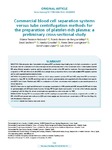Commercial Blood Cell Separation Systems Versus Tube Centrifugation Methods for the Preparation of Platelet-Rich Plasma: A Preliminary Cross-Sectional Study

Use this link to cite
http://hdl.handle.net/2183/29755
Except where otherwise noted, this item's license is described as Atribución-NoComercial 4.0 Internacional
Collections
- Investigación (FEP) [512]
Metadata
Show full item recordTitle
Commercial Blood Cell Separation Systems Versus Tube Centrifugation Methods for the Preparation of Platelet-Rich Plasma: A Preliminary Cross-Sectional StudyAuthor(s)
Date
2021-04Citation
Trevisson-Redondo, Bibiana et al. Commercial blood cell separation systems versus tube centrifugation methods for the preparation of platelet-rich plasma: a preliminary cross-sectional study. Revista da Associação Médica Brasileira [online]. 2021, v. 67, n. 4 [Accessed 10 February 2022] , pp. 536-541. Available from: <https://doi.org/10.1590/1806-9282.20200989>. Epub 06 Sept 2021. ISSN 1806-9282. https://doi.org/10.1590/1806-9282.20200989
Abstract
[Abstract] OBJECTIVE: Clinical studies claim that platelet-rich plasma (PRP) accelerates tissue healing due to its high concentration of growth
factors and that the combination with leukocytes improves the antimicrobial effect of the concentrate. Most of these studies obtained
PRP using different separation systems, and few analyzed the content of the PRP used for treatment. This study characterized the
composition of PRP and white blood cells (WBC) from a single donor produced by three commercially available PRP separation systems
and two anticoagulated general analytical tubes.
METHODS: Five patients donated 50 mL of blood, which was processed to produce PRP and WBC using three PRP concentration
systems (i.e., Easy PRP Kit, GloPRP, and Wego) and two tubes for general analysis anticoagulated with ethylenediaminetetraacetic
acid (EDTA) and citrate. Platelets and WBC in combination with their concentrates were analyzed by automated systems in a
clinical laboratory.
RESULTS: There were no significant differences in the average concentrations of PRP platelets and WBC between GloPRP and the tubes
for general analysis with EDTA and citrate; however, the Easy PRP Kit gave results much superior to the rest of the methods, especially
comparing it with the Wego Kit, whose concentrates were especially low, even nonexistent for WBC.
CONCLUSIONS: The Easy PRP Kit concentrates WBC-rich PRP, resulting in increased WBC concentrations, compared with low WBC-low
PRP of GloPRP and general tube methods for EDTA and citrate analysis and the even lower concentration of PRP from the Wego Kit,
with the absence of leukocytes
Keywords
Platelet-rich plasma
Plasma rico en plaquetas
Blood
Sangre
Leukocytes
Leucocitos
Plasma rico en plaquetas
Blood
Sangre
Leukocytes
Leucocitos
Editor version
Rights
Atribución-NoComercial 4.0 Internacional






